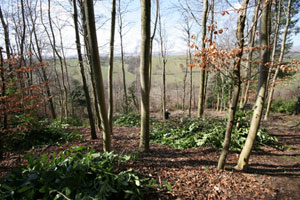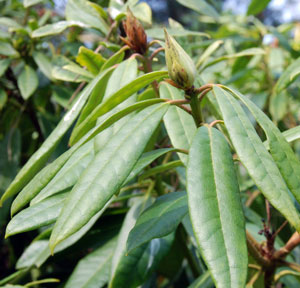Laurel removal

We inherited a lot of Cherry Laurel in our 3 acre wood. It occupied about 2/3rd acre, growing under tall ash and beech trees. It was probably planted there by the Victorians to act as cover for pheasants. Judging by the number of pheasants around the wood, it certainly did just that!
When we bought the wood, in 2001, the laurel had been cut back to the ground and we did not realise what a problem it would be. The laurel bushes that looked so small then grew hugely until they towered above our heads, cutting out the light from the woodland floor and preventing new growth. There was little or no ground flora or understorey in this area. We were novices at woodland management - learning on the job. We eventually realised that laurel was not an indigenous species and ought to be eradicated, but what a daunting task!
So, we experimented on how to best eradicate it, taking the following into consideration:
- If lopped laurel branches are left to lie on the ground, they can take root and sprout new growth, all along the length!!
- We wanted to avoid using herbicides in the wood as much as possible.
- Digging the roots out was not an option for us and as laurel will produce suckers if the roots are damaged, we would need to get every part of it out.
This is the method we developed.
- Make a low ‘raft’ about 2 x 3 m2 of any dead wood or loppings, except laurel
- Lop the laurel, cutting as low as possible. We used Wilkinson Sword long handled ratchet loppers for the smaller stems and a chainsaw for anything too big for the loppers.
- Pile the newly lopped laurel onto the raft, to make a brash heap. This prevents the laurel stems from touching the ground and taking root.
- Where possible, build the rafts and brash heaps right on top of newly cut laurel stools. This excludes the light from them and discourages new growth from the stool – very important.
 The laurel did re-grow although it took one or two years for very scanty new growth to struggle through the brash heaps. We found that the laurel stools that did not have a covering brash heap soon produced fresh strong young growth. So then we resorted to using herbicide (we used Roundup, with a pump spray and lance). We were against using herbicides in the wood, so we used it very, very sparingly – just enough to wet the laurel leaves. The lance allowed accurate spraying so that the surrounding herbage was not affected. We sprayed before the growth became vigorous. This way we were not spraying large areas and hence the volume of herbicide used was small. The plant takes the poison down into the root and dies. There is no harmful residue.
The laurel did re-grow although it took one or two years for very scanty new growth to struggle through the brash heaps. We found that the laurel stools that did not have a covering brash heap soon produced fresh strong young growth. So then we resorted to using herbicide (we used Roundup, with a pump spray and lance). We were against using herbicides in the wood, so we used it very, very sparingly – just enough to wet the laurel leaves. The lance allowed accurate spraying so that the surrounding herbage was not affected. We sprayed before the growth became vigorous. This way we were not spraying large areas and hence the volume of herbicide used was small. The plant takes the poison down into the root and dies. There is no harmful residue.
If the laurel re-grew after this first spraying, we gave another dose of spray and a third if necessary. We found that about 40% of the laurel died from the first spraying and another 40% from the second one. The last spray should finish off any persistent plants. We did pull up the odd small weak plants that had not developed a large root system.
The drawback to this method is that the heaps of brash look unsightly. The dying evergreen leaves take a season to drop off the stems. The branches then took another two or three years to rot away. It’s not a good idea to chip the brash as the chippings can take root On the plus side, it did work well and the brash heaps provided homes for small rodents, frogs and birds. Also, we made good charcoal from some of the laurel poles!
However, we were spending so much time just working on laurel bashing that other woodland tasks were being neglected. There was still a huge amount of laurel waiting to be treated. Then, in 2006, we met our local Woodland Officer at a wood fair and discovered that we could get a 75% grant through the Better Woodland for Wales scheme, to eradicate the rest of the laurel. The plan was for contractors to cut down the laurel, paint the stumps greater than 100mm diameter with a herbicide within 48 hours of cutting and remove the brash from the wood. Any new growth would need to be sprayed with herbicide periodically until the laurel was dead.
 The grant application was successful and contractors carried out the work during 2007. Then we took over again and have carefully sprayed any re-growth (of which there was very little) twice a year. This spring (2010) I would say that 99.9% of the laurel is dead. Many of the old stumps are rotten and break up when kicked. Where there was next to no under storey in the area where the laurel grew but there are now ash saplings and wild flowers colonising the area. That part of the wood is going to look very different in future.
The grant application was successful and contractors carried out the work during 2007. Then we took over again and have carefully sprayed any re-growth (of which there was very little) twice a year. This spring (2010) I would say that 99.9% of the laurel is dead. Many of the old stumps are rotten and break up when kicked. Where there was next to no under storey in the area where the laurel grew but there are now ash saplings and wild flowers colonising the area. That part of the wood is going to look very different in future.
In summary, I would say that if you only have a small area of laurel, then our DIY method would be just fine. However, if you have a large area, it is well worth applying for a grant for the work to be done. Would the same method work for Rhododendron ponticum ? I don’t know but it would be worth a try.
Comments are closed for this post.
Discussion
Where can one legally dispose of laurel cut down? (In Wiltshire?)
Bushes were planted in MAY ABOUT 6 in a row to afford privacy. However the first bush started turning brown and was dead now the one next to it started the same turned brown and died now rhe next bush doing the same thing. The installer is telling me it’s water damage but the three remaining bushes are growing nicely but for how long. What can be done. Is this a disease problem. There’s nothing I can do. Please advise. Thank you
I have had my neighbours laurel cut back to put a fence up (with their blessing) but there was one low branch laying on the ground my side. Its started shooting so dug it out but couldn’t get right down to the some of the roots. I’ve cut out as much as I can. To about 2 foot deep. Will that regrow?
Walking in Melton Woods Doncaster we noticed what we thought were azaleas planted in a certain area. They all looked as though they are dying. Brought a piece home to check and found it was laurel. It seems to be a pest, and looks as though it’s been sprayed.
After reading a little more it gives suggestions on how to get rid of it, included using Roundup. They certainly look as though they are dying. Is this woodland management by Doncaster met council.
I’ve just dug out three established laurel trees. I mean the core but is this them finished as I hear they’re notorious?
Is there anything else I should do??
Many thanks
Got some mature laurel trees we want to remove . They are 20 foot tall what would it cost if I cut down leaving the stump to be took out by professional .
In answer to the question at end of above, re rhodo ponticum – the answer is yes it would work.
Always bear in mind that both rhodo and laurel will re-establish/recolonise if there is significant ground disturbance which causes seed to be moved around the area, and also there may be vegetative regeneration; the latter is a particular problem where deep mulching is done with a forest-mulcher to clear a site – it actually perpetuates the problem!
I know as I have been called in on 2 sites that were mulched some 3 and 5 years back, and its now a long term knapsack sprayer job each spring and autumn to kill the widespread regen.

Maryrose, Feb 2020 :
We have chipped lots of Laurel.
It stinks but it doesn’t regrow. It makes an effective anti-weed barrier.
We used it on paths. It rots down in about 3 years.
Maryrose
15 February, 2022